In the world of modern engineering, precision and efficiency are paramount. Variable Frequency Drives (VFDs) have emerged as a crucial technology that enhances the performance of electric motors and significantly contributes to energy conservation. This comprehensive article explain deeply into the technical aspects of VFDs, unraveling their working principle, functions, motor compatibility, types, advantages, disadvantages, applications, and more.
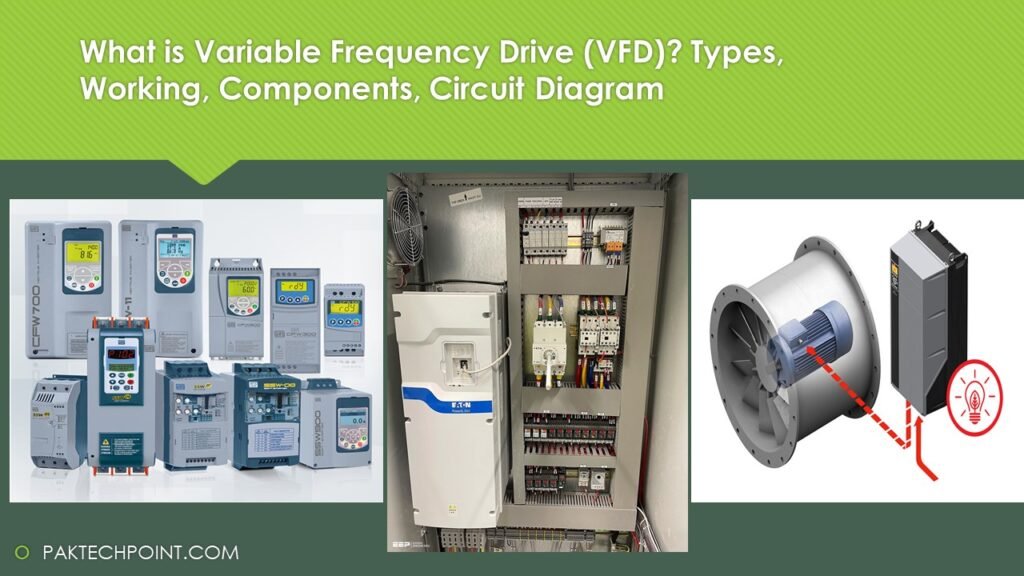
VFD Meaning in Electrical:
In the realm of electrical engineering, VFD stands for Variable Frequency Drive. This device plays a pivotal role in modern motor control and energy-efficient applications. It is also called adjustable speed drive and frequency inverter.
DIFFERENT PULSE VFDs
Read Also:
What is a Variable Frequency Drive (VFD)?
A Variable Frequency Drive (VFD), also known as a Variable Speed Drive (VSD) or Adjustable Frequency Drive (AFD), is a sophisticated device used to control the speed and torque of electric motors. It achieves this by changing the frequency and voltage of the power supply to the motor. In simpler terms, a VFD allows precise control over how fast a motor rotates and how much force it generates.
Here’s how it works: The motor’s speed is influenced by the frequency of the power it receives, while the voltage determines how much force, or torque, the motor produces. By adjusting these factors, a VFD can finely adjust how a motor performs to match specific needs.
There are different types of VFDs, categorized based on how they work and the type of load they’re connected to. One common type is the Voltage Source Inverter (VSI). It takes a fixed-frequency AC power input and converts it into variable-frequency AC output. This involves converting the AC input to DC, then using an inverter to switch the DC to produce a modified AC output.
A key feature of VFDs is how they regulate the output voltage and frequency. One method is Pulse Width Modulation (PWM), where the VFD creates a series of pulses with varying width to mimic a smooth sine wave. This technique is efficient and simple.
The control system of a VFD plays a critical role. It continuously monitors feedback signals from the motor and adjusts the output accordingly. This ensures that the motor operates as desired.
It is used to control AC motor speed and torque by varying input voltage and frequency of incoming supply. Used in Electro mechanical system.

Working Principle of VFD:
The fundamental principle behind VFD operation lies in the modulation of voltage and frequency. A VFD first rectifies the incoming AC power into DC power through diodes. This DC power is then converted back into AC using a set of Insulated Gate Bipolar Transistors (IGBTs). By varying the width of the pulses in the IGBT switching, the frequency of the output AC waveform can be adjusted. This change in frequency directly impacts the motor’s speed.
Read Also: What is Switchgear?
VFD Components:
The following components are used in the VFD.
I. Rectifier
Rectifier is the simple circuitry of electronics devices that converts the incoming alternating voltage to direct current (DC supply). Different designs can be used of rectifier for VFD operation. It can also control the direction of power flow. This DC Power has voltage ripples so next we have to smoothing the voltage.
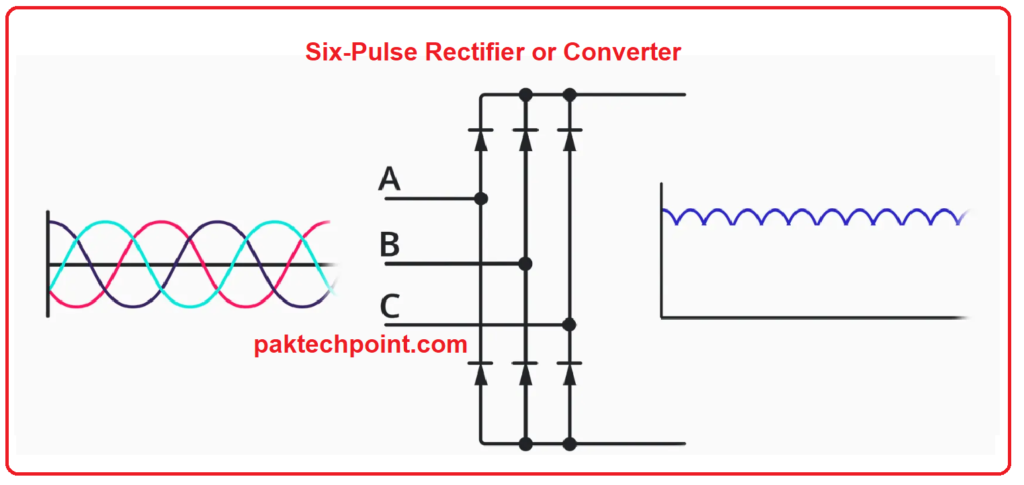
II. Intermediate Circuit or DC Link
Intermediate circuit consists of inductors and filter capacitors circuits. This step performs voltage smoothing.

III. Inverter
The inverter again change the rectified and DC Conditioned output to alternating voltage (AC). At the inverter’s end output, the PWM (Pulse Width Modulation) technique is used with help of special types of transistors like IGBT (Insulated gate bipolar junction transistors) to get high frequency pulse width modulated signal with effective voltage.
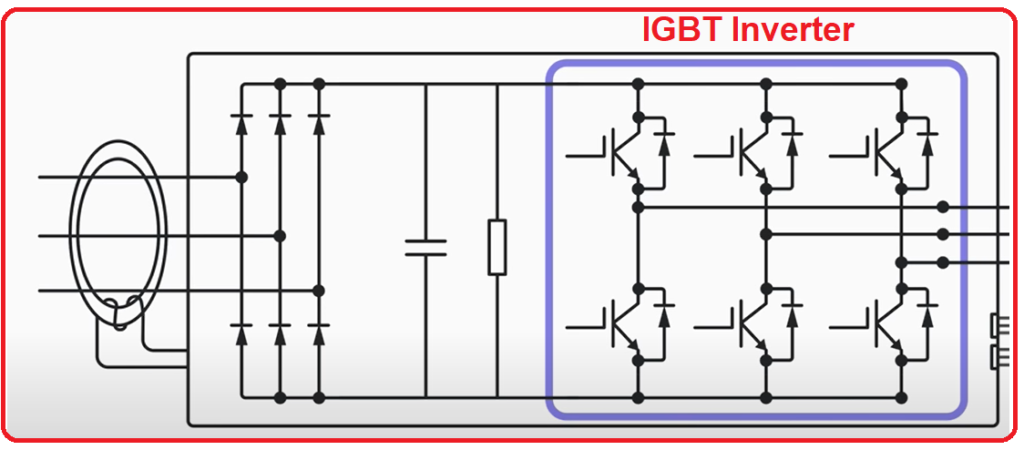
How this technique works?
The answer is simple the IGBT circuitry turns ON and OFF at high frequency with duration of on-time or width of pulse, controller to approximate sinusoidal waveform.
IV. Control Unit
As name describes, it controls all the operations of VFD like rectification, intermediate circuit and invert to get correct output. It contains the processor which governs overall operation.
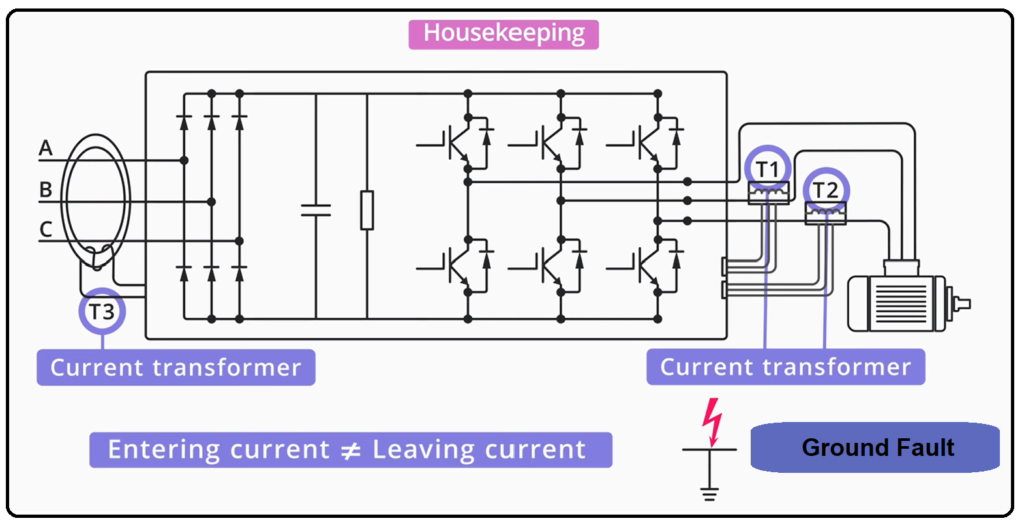
Functions of VFD:
- Speed Control: The primary function of a VFD is to adjust the speed of an electric motor, ensuring it operates at the optimal speed for a given application.
- Energy Savings: VFDs enable energy savings by reducing the motor’s speed when full power isn’t necessary, leading to reduced energy consumption.
- Soft Start and Stop: VFDs offer smooth acceleration and deceleration of motors, preventing mechanical stress and wear during start-up and shutdown.
- Process Control: VFDs enhance process control by allowing precise adjustment of motor speed, contributing to improved product quality and consistency.
VFD Motor Compatibility:
VFDs are compatible with various types of motors, including induction motors and synchronous motors. However, induction motors are more commonly used due to their simplicity, ruggedness, and cost-effectiveness. Synchronous motors, though more efficient at constant speed, require additional measures to maintain synchronization with varying frequencies.
VFD Panel:
A VFD panel serves as the central control unit for the Variable Frequency Drive system. It houses the VFD controller, power electronics, control circuitry, and interfaces for external controls. The panel design is critical for ensuring safety, efficient cooling, and ease of maintenance.
VFD Inverter:
The VFD inverter is the heart of the VFD system. It converts DC power to variable-frequency AC power using semiconductor switches. The inverter’s modulation techniques determine the output waveform’s quality and accuracy, influencing motor performance.
VFD Circuit Diagram:
A typical VFD system comprises various components, including an AC-DC rectifier, a DC bus, an inverter, and a controller. These components are interconnected, forming a complex system that controls the motor’s speed and performance. A detailed Variable Frequency Drive diagram illustrates the flow of power and control signals.
The circuit diagram and block diagram is shown below

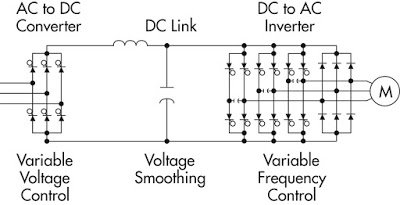
Circuit diagram of VFD
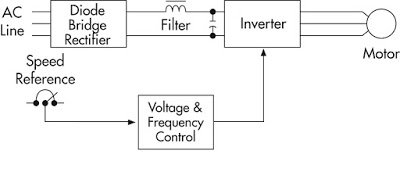
Types of VFDs:
- Voltage Source Inverter (VSI): VSI is the most common type, where the DC voltage remains constant, and the output frequency is varied by changing the pulse width.
- Current Source Inverter (CSI): In CSI, the output current remains constant, and the frequency is controlled by changing the pulse width.
- Pulse Width Modulation (PWM) VFDs: PWM VFDs are the most prevalent, utilizing high-frequency pulses to control the motor’s speed and voltage.
- Matrix Converter VFDs: These advanced VFDs use a matrix of semiconductor switches to directly convert AC power to the desired frequency and voltage.
What are Reasons to use VFDs in Industry?
adjusting motor speed using Variable Frequency Drives (VFDs) offers a range of benefits and applications. VFDs provide a sophisticated solution to control the speed of electric motors and offer a plethora of advantages across various industries. Here’s a more detailed look into the reasons and benefits of adjusting motor speed with VFDs:
- Energy Efficiency and Cost Savings: One of the primary motivations for using VFDs is energy efficiency. By adjusting the speed of the motor to match the load requirements, Variable Frequency Drives prevent motors from running at full speed even when less power is needed. This leads to significant energy savings and reduced operating costs.
- Hybridization and Power Conversion: In hybrid and electric vehicle applications, VFDs play a crucial role in converting power between battery packs and the drivetrain. By adjusting the frequency of the voltage supplied to the motor, VFDs enable smooth transitions between different power sources.
- Process Requirements Matching: Different processes demand varying speeds. VFDs allow motors to run at the optimal speed required by the process, ensuring that machinery operates efficiently and product quality is maintained.
- Torque and Power Matching: Some applications require adjustable torque or power delivery. VFDs enable precise control over these parameters, making them suitable for applications like conveyors, cranes, and pumps.
- Improved Working Environment: In HVAC systems, VFDs can regulate fan and pump speeds to maintain a comfortable working environment without sudden airflow or pressure changes.
- Noise Reduction: Operating motors at full speed can result in excessive noise. By controlling the motor speed with Variable Frequency Drives, noise levels can be significantly reduced, making the workplace quieter and more comfortable.
- Mechanical Stress Reduction: Running motors continuously at high speeds can lead to wear and tear, reducing their lifespan. VFDs allow gradual acceleration and deceleration, minimizing stress on mechanical components and extending the motor’s operational life.
- Peak Demand Management: Industries often experience peak demand periods, leading to higher energy costs. VFDs can be programmed to limit peak consumption by slowing down motors during these periods, thus avoiding peak-demand charges.
- Optimized System Performance: VFDs offer precise control over motor speed and acceleration, ensuring that processes run smoothly and avoiding sudden starts or stops that could disrupt operations.
- Reduced Maintenance Costs: By minimizing stress on equipment and optimizing motor performance, VFDs can lead to reduced maintenance requirements and associated costs.
- Space and Size Efficiency: In some cases, using a smaller motor with a Variable Frequency Drive can achieve the same output as a larger motor without a VFD. This saves space and reduces equipment costs.
- Regenerative Braking: VFDs can provide regenerative braking capabilities, converting kinetic energy back into electrical energy, which can be reused or dissipated.
- Remote Control and Monitoring: VFDs often come with advanced control features, allowing remote adjustments and real-time monitoring of motor performance, making them suitable for various industrial applications.
Pros and Cons of VFDs:
Advantages:
- Energy Savings: VFDs significantly reduce energy consumption by operating motors at optimal speeds.
- Soft Start: VFDs eliminate the need for mechanical starters, enabling smooth and stress-free motor start-ups.
- Process Control: VFDs provide precise speed control for applications requiring accuracy and consistency.
- Reduced Wear: Soft start and adjustable speed reduce mechanical wear and increase motor lifespan.
Disadvantages:
- Harmonics Generation: VFDs can introduce harmonics into the power supply, necessitating harmonic filters.
- Complexity: Variable Frequency Drive systems can be complex to design, install, and maintain, requiring skilled personnel.
- Cost: Initial investment and maintenance costs of VFD systems can be higher than traditional methods.
Applications of VFDs:
VFDs find applications in various industries, including manufacturing, HVAC, water treatment, mining, paper mills, and more. They are employed in pumps, fans, conveyors, mixers, compressors, and other motor-driven equipment.
Advanced and Modern VFD Examples
- Regenerative VFDs: These VFDs capture and feed back excess energy to the power supply, enhancing energy efficiency.
- Sensorless Vector Control VFDs: These VFDs offer precise control without requiring motor feedback sensors, reducing system complexity.
- Ethernet-enabled VFDs: Modern VFDs come equipped with Ethernet connectivity for remote monitoring, control, and diagnostics.
Conclusion:
Variable Frequency Drives (VFDs) represent a pivotal advancement in the world of motor control and energy efficiency. By enabling precise speed control, energy savings, and enhanced process performance, VFDs have transformed various industries. Understanding the intricate workings of VFDs, their functions, motor compatibility, types, advantages, disadvantages, and applications is essential for harnessing their full potential in modern engineering.
Top Manufacturers list of Variable Frequency Drive
- ABB
- Danfoss
- Allen Bradley
- Siemens
- Schneider
- Yaskawa
- Teco
- Mitsubishi
- Crompton Greaves Consumer Electricals Limited
- Fuji
- L&T
- Weg
- Eaton
- Toshiba
- Grundfos
- Vacon
- ac tech
- Hitachi
- Lenze
- Magnetek
- Reliance electric
- Rockwell
- LG
- Omron
- Sew Eurodrive
Why we use Variable Frequency Drive?
What is Principle and Operation of VFD?
What are Benefits of VFDs?
What is Importance of Variable Frequency Drive?
If you use VFDs technically and professionally, 25 to 35 percent energy can be saved. Only need to evaluate complete evaluation industrial package for power savings. Furthermore, it makes sure reduction of motor starter and exerts less stress on motor windings and bearings.
Read Also: Three phase connections Star and Delta Connections
Read Also: What are 5 VFD Drive Operations?
I think other site proprietors should take this web site as an model, very clean and great user genial style and design, as well as the content. You’re an expert in this topic!